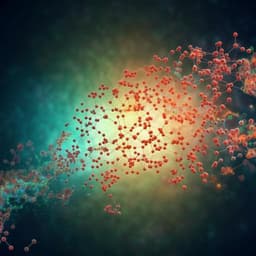
Medicine and Health
C9orf72-ALS human iPSC microglia are pro-inflammatory and toxic to co-cultured motor neurons via MMP9
B. F. Vahsen, S. Nalluru, et al.
This groundbreaking research conducted by Björn F. Vahsen and colleagues uncovers the toxic effects of *C9orf72* hexanucleotide repeat expansions in microglia, revealing their deleterious impact on motor neurons through MMP9 signaling. Discover how this cellular dysfunction contributes to the pathophysiology of ALS.
Playback language: English
Introduction
Amyotrophic lateral sclerosis (ALS) is a devastating neurodegenerative disease primarily characterized by the progressive loss of motor neurons (MNs) in the brain and spinal cord. This MN loss leads to progressive paralysis and ultimately death, typically within three years of symptom onset. The disease's pathogenesis is complex and involves both cell-autonomous neuronal dysfunction and non-cell-autonomous factors driven by interactions with non-neuronal cells, particularly microglia. Microglia, the resident immune cells of the central nervous system (CNS), play a crucial role in maintaining neuronal homeostasis, performing functions such as synapse pruning, phagocytosis of cellular debris, and the regulated release of cytokines and chemokines. However, under pathological conditions, microglia can become activated and adopt a pro-inflammatory phenotype, contributing to neurotoxicity.
In ALS, widespread microglial activation is a prominent feature, particularly in patients with hexanucleotide repeat expansions (HRE) in the *C9orf72* gene, the most common genetic cause of ALS. The HRE mutation in *C9orf72* leads to various pathogenic mechanisms, including *C9orf72* haploinsufficiency, the formation of RNA foci and dipeptide repeats (DPRs), and mislocalization of TDP-43, all contributing to neuronal dysfunction. While *C9orf72* is highly expressed in myeloid cells, including microglia, the precise consequences of the HRE on microglial function have been less well understood. Previous studies in murine models have shown that *C9orf72* loss-of-function results in a pro-inflammatory state in myeloid cells and microglia, contributing to neuronal toxicity. However, it remained unclear whether human *C9orf72* HRE mutant microglia exhibit similar pathological features, display a characteristic disease phenotype, or exert non-cell-autonomous effects on neurons.
This study utilizes human induced pluripotent stem cell (iPSC)-derived microglia to comprehensively investigate the cellular and molecular consequences of the *C9orf72* HRE mutation. The authors leverage their established protocols for differentiating human iPSCs into microglia, both in monoculture and in co-culture with MNs, allowing for a detailed investigation of the microglial phenotype and its impact on MNs.
Literature Review
The existing literature on the role of microglia in ALS and the consequences of *C9orf72* mutations provided a strong foundation for this study. Studies have consistently linked microglial activation to ALS disease progression, with increased microglial activation correlating with symptom severity and upper motor neuron clinical symptoms. Furthermore, research has highlighted the connection between microglial activation and the accumulation of TDP-43 pathology, a key hallmark of ALS. The discovery of the *C9orf72* HRE mutation as the most common genetic cause of ALS spurred further investigation into its effects on microglial function. Mouse models with *C9orf72* knockout demonstrated a pro-inflammatory state in myeloid cells and microglia, suggesting a potential mechanistic link between *C9orf72* dysfunction and microglial-mediated neurotoxicity. However, these murine models did not fully capture the complex gain-of-function effects of the HRE mutation observed in human patients. The need for studies using human cells, specifically human iPSC-derived microglia, to understand the nuanced effects of the *C9orf72* HRE on microglial function and subsequent neurotoxicity was a key driver for this research.
Methodology
This study employed a robust and well-characterized protocol for the differentiation of human iPSCs into microglia. The researchers used iPSC lines derived from three *C9orf72*-ALS patients, three age- and sex-matched healthy controls, and a crucial isogenic control line generated through CRISPR-mediated homology-directed repair. This isogenic control line allowed the researchers to isolate the effects of the HRE from other potential confounding genetic variations. Microglial differentiation was performed using an established embryoid body (EB)-based protocol, yielding microglia precursors with characteristics resembling bona fide human microglia. Microglial functionality was validated through several assays, including immunofluorescence staining for microglial markers (IBA1 and TMEM119), Western blotting, RT-qPCR, and phagocytosis assays using pHrodo zymosan particles. The effects of LPS priming, a potent activator of microglia, were also investigated.
RNA sequencing was performed on both unstimulated and LPS-primed microglia from all lines to identify transcriptomic changes associated with the *C9orf72* HRE. The resulting data were subjected to principal component analysis (PCA) and gene set enrichment analysis (GSEA) to identify differentially expressed genes (DEGs) and pathways enriched in *C9orf72* mutant microglia compared to controls. The release of cytokines and chemokines from microglia was assessed using supernatant arrays and ELISAs.
To investigate the non-cell-autonomous effects of *C9orf72* mutant microglia, co-culture experiments were performed using healthy spinal MNs and microglia. Co-cultures were established at a 1:1 ratio, reflecting the physiological glia:neuron ratio, and were maintained for varying durations to assess both short-term and long-term effects. The impact of *C9orf72* mutant microglia on MNs was evaluated using several assays, including immunocytochemistry for apoptotic markers (cleaved caspase 3), Western blotting, patch-clamp electrophysiology, multi-electrode array (MEA) recordings to assess neuronal activity, and quantification of neurite outgrowth and synaptophysin expression to analyze synaptic function. The effects of LPS priming, both with and without the application of an MMP9 inhibitor, were investigated to determine the mechanistic role of MMP9 in microglial-mediated neurotoxicity. The researchers also analyzed the release of various cytokines and chemokines in the co-culture supernatants.
Key Findings
This study yielded several crucial findings demonstrating both cell-autonomous and non-cell-autonomous effects of the *C9orf72* HRE on microglia. First, *C9orf72* mutant microglia exhibited key pathological features associated with the HRE mutation, including *C9orf72* haploinsufficiency (compared to healthy controls), the expression of DPRs Poly(GA) and Poly(GP), and the formation of sense and antisense RNA foci. Interestingly, TDP-43 mislocalization was not observed in these mutant microglia.
RNA sequencing revealed a significant dysregulation of pathways in *C9orf72* mutant microglia, especially after LPS priming. Enriched pathways included those associated with immune cell activation and cytokine/chemokine activity, while pathways associated with lysosomes and the endoplasmic reticulum (ER) showed negative enrichment. Importantly, the expression and release of MMP9 were consistently upregulated in LPS-primed *C9orf72* mutant microglia compared to both healthy and isogenic controls.
In co-culture experiments, unstimulated *C9orf72* mutant microglia did not exert overt neurotoxicity on healthy MNs. However, LPS priming revealed a significant increase in the expression of apoptotic markers in MNs co-cultured with *C9orf72* mutant microglia. Prolonged LPS exposure resulted in significant neurodegeneration, with a reduction in the number of surviving MNs. Crucially, the neurotoxic effects of LPS-primed *C9orf72* mutant microglia were significantly ameliorated by the concomitant application of an MMP9 inhibitor, strongly implicating MMP9 as a key mediator of microglial-mediated neurotoxicity. The study also identified DPP4 release into the co-culture supernatant as an MMP9-dependent marker of microglial dysfunction, with DPP4 levels decreasing upon MMP9 inhibition.
Discussion
The findings of this study provide compelling evidence for a novel mechanism underlying the contribution of microglia to *C9orf72*-ALS pathogenesis. The demonstration of both cell-autonomous (pathological features and transcriptomic changes) and non-cell-autonomous (neurotoxicity in co-culture) effects of the *C9orf72* HRE in human iPSC-derived microglia is a significant advance in the field. The consistent upregulation and release of MMP9 in *C9orf72* mutant microglia, particularly after LPS priming, and its critical role in mediating neurotoxicity highlight MMP9 as a potential therapeutic target. The identification of DPP4 as an MMP9-dependent marker of microglial dysfunction also opens avenues for developing novel biomarkers for disease monitoring and treatment response assessment.
This research aligns with previous findings demonstrating the importance of *C9orf72* in myeloid cells and microglia, but it extends these findings by demonstrating the importance of the HRE's gain-of-function effects on microglial dysfunction, especially in the context of a pro-inflammatory environment. The use of human iPSC-derived cells is a significant strength of this study, as it addresses limitations of previous murine models that did not fully recapitulate the complexity of human disease. The findings suggest a model where latent neurotoxicity of *C9orf72* mutant microglia is unmasked under pro-inflammatory conditions.
Conclusion
This study provides robust evidence for the dysfunction of *C9orf72* HRE mutant microglia and their role in driving neurodegeneration in *C9orf72*-ALS. The identification of MMP9 as a key mediator of microglial-mediated neurotoxicity opens exciting possibilities for therapeutic intervention. Further research should focus on validating MMP9 and DPP4 as biomarkers in *C9orf72*-ALS patients and investigating the potential of MMP9 inhibitors as therapeutic agents. Investigating the interactions between *C9orf72* mutant microglia and other cell types, including astrocytes, and exploring the long-term effects of microglial dysfunction on neuronal function and synaptic plasticity would further enhance our understanding of this complex neurodegenerative disease.
Limitations
While this study represents a significant advancement in our understanding of *C9orf72*-ALS pathogenesis, some limitations should be considered. The co-culture experiments used healthy MNs, excluding the potential influence of simultaneous *C9orf72* mutations in neurons. The duration of the co-culture experiments was relatively short, and long-term effects on synaptic function may not have been fully captured. Future studies should address these limitations to provide a more complete picture of the complex interplay between *C9orf72* mutant microglia and neurons in ALS.
Related Publications
Explore these studies to deepen your understanding of the subject.







